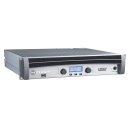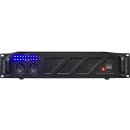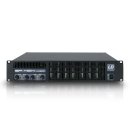Comprehensive Guide to PA Amplifiers for Professional Sound Systems
PA amplifiers are at the heart of any high-performance sound system, powering speakers to deliver clear, dynamic audio in live performances, events, and installations. Whether you're setting up a small venue, managing a large-scale concert, or building a professional audio setup, choosing the right PA amplifier is essential for ensuring consistent, powerful sound. In this guide, we’ll explore the core functionalities of PA amplifiers, how to choose the best one for your needs, and discuss advanced topics like active vs. passive systems, DSP integration, and proper maintenance to ensure optimal performance.
What Is a PA Amplifier and How Does It Work?
A PA (public address) amplifier is designed to boost the low-level audio signal from a mixer or sound source and provide enough power to drive speakers for sound reinforcement. This is particularly important in live sound applications where sound must be projected over long distances and reach large audiences. PA amplifiers are built to handle demanding conditions, offering the power and reliability needed for concerts, conferences, and large-scale events.
One key difference between a PA amplifier and a traditional home audio amplifier is its power capacity. PA amplifiers are generally much more powerful, capable of delivering high wattage to multiple speakers. This ensures that the sound remains clear, even at high volumes, making them ideal for large venues. Additionally, many PA amplifiers include features such as built-in limiters and fans to protect against overheating and overload, providing peace of mind in challenging environments.
Choosing the Right PA Amplifier for Your System
Selecting the right PA amplifier depends on several factors, including the size of your venue, the type of event, and the specific requirements of your sound system. One of the most important considerations is the power rating, which is measured in watts. When choosing the best PA amplifier for live performances, it’s crucial to ensure that the amplifier’s power output matches the requirements of your speakers. A general rule of thumb is to choose an amplifier with a power rating that is 1.5 to 2 times the speaker’s continuous power rating (RMS).
Another key consideration is whether to use an active or passive system. Active vs. passive PA amplifiers offer different advantages. Active systems have built-in amplification, simplifying the setup process and reducing the number of components needed. Passive systems, on the other hand, require an external amplifier, giving you more flexibility in terms of customization and scalability. For example, a passive system allows you to pair different amplifiers with various speakers based on the specific requirements of each venue or event.
For those looking to optimize their sound further, PA amplifiers with built-in DSP (digital signal processing) provide advanced features such as EQ, crossover control, and feedback suppression. These amplifiers allow you to fine-tune your sound system directly from the amplifier, giving you greater control over your audio output and helping you achieve professional-level sound quality.
Understanding Amplifier Classes: A, B, and D
PA amplifiers are classified into different categories based on their circuit design, with Class A, B, and D being the most common in live sound reinforcement. Each class has its own set of benefits and trade-offs. Class A PA amplifiers offer high-quality sound with low distortion but tend to be less efficient, generating more heat and using more power. This makes them less common in large-scale live sound setups.
Class B and Class AB amplifiers provide a balance between efficiency and sound quality, making them popular in mid-size venues and applications where a mix of power and clarity is needed. These amplifiers have a higher efficiency than Class A but still produce excellent sound reproduction.
Class D PA amplifiers, often referred to as switching amplifiers, are the most efficient option and have become the standard for live sound and large venues. Class D amplifiers are lightweight, run cooler, and are highly efficient in terms of power consumption, making them ideal for situations where high power output is required without the bulk and heat of traditional amplifiers. Class D amplifiers are often used in professional PA amplifier systems where multiple speakers need to be driven at high volumes for extended periods.
Maintaining and Protecting Your PA Amplifier
Proper maintenance is essential for ensuring the longevity and performance of your PA amplifier. One of the key aspects of maintenance is keeping the amplifier cool. Overheating is a common cause of failure in high-power amplifiers, especially in environments where they are running at high volumes for extended periods. Most modern amplifiers come equipped with internal cooling systems, such as fans and heat sinks, but it’s important to ensure these are functioning properly. Make sure the amplifier has adequate ventilation, and avoid placing it in enclosed spaces where heat can build up.
Another important aspect is to regularly check your amplifier’s connections and wiring. Loose connections can cause intermittent signal loss or introduce noise into the sound system. Additionally, keep an eye on power levels to avoid overloading your system. Many PA amplifiers with built-in limiters will automatically prevent the system from being overdriven, protecting both the amplifier and the speakers from damage.
In terms of overall care, regularly cleaning the amplifier’s exterior and ensuring that dust does not accumulate around the vents and fan grilles will help maintain airflow and prevent overheating. Storing your amplifier in a protective case when not in use, particularly during transport to and from venues, will also help extend its lifespan and ensure it continues to perform at its best.
Using PA Amplifiers for Different Venues and Events
The versatility of a PA amplifier allows it to be used in a wide range of settings, from small intimate gigs to large outdoor festivals. Choosing the right amplifier for the size of the venue is critical for delivering high-quality sound. For smaller venues or indoor spaces, a budget-friendly PA amplifier for smaller concerts may be sufficient, offering enough power to drive a couple of speakers without overwhelming the space. These amplifiers are also ideal for mobile DJs or small band setups that require portability and ease of use.
In contrast, larger venues and outdoor events will require a more powerful system. Powerful PA amplifiers for large sound systems are designed to handle higher wattage and multiple speakers, ensuring that the sound can cover greater distances without losing clarity. Outdoor setups, in particular, require careful consideration of amplifier power, as sound tends to dissipate more quickly in open spaces. High-power amplifiers with sufficient headroom ensure that your sound remains clear and undistorted, even at higher volumes.
Whether you are running sound for a small event or a large-scale concert, the right PA amplifier can make all the difference in achieving clear, powerful audio. By understanding the various options available and ensuring your amplifier is properly maintained, you can deliver an exceptional sound experience for any audience.






